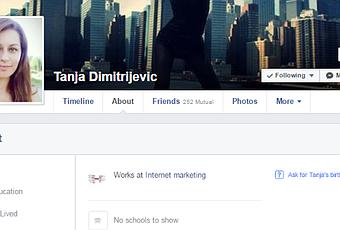Introduction
In the sprawling digital landscape of Facebook, authenticity is often a fleeting illusion. With the ease of creating multiple accounts and impersonating others, the platform has become a haven for fake profiles. These imposters can lurk in the shadows, preying on unsuspecting users for personal gain or nefarious purposes. As a discerning social media navigator, it’s imperative to possess the keen eye to separate the authentic from the artificial.

Image: en.paperblog.com
This comprehensive guide will equip you with the knowledge and tools to unveil the truth behind questionable Facebook profiles. We will delve into the telltale signs, both subtle and glaring, that can help you identify and avoid falling prey to these digital deceivers.
Section 1: The Profile Picture Paradox
The profile picture often serves as the face of an online persona. It can reveal a wealth of information about the individual behind the profile. For fake profiles, the picture often holds clues that betray their authenticity:
- Grainy or low-quality images: Real users are more likely to share high-resolution images that clearly depict their face or likeness. Fake profiles, on the other hand, may resort to using blurry or pixelated images to conceal their true identity.
- Inconsistent facial features: Scrutinize the profile picture carefully for any inconsistencies in facial features. Fake profiles may use pictures that have been digitally altered or manipulated, resulting in mismatched eyes, noses, or mouths.
- Stolen or copyrighted images: Using an image search engine, such as Google Lens, can help you determine if the profile picture has been stolen from another source or is copyrighted. If the image appears on multiple profiles or websites, it’s a red flag.
Section 2: The Bio and Timeline: A Trail of Breadcrumbs
The bio and timeline can provide valuable insights into the user’s personality and activity. Discrepancies or oddities in these sections can point towards a fake profile:
- Insufficient or vague information: Real users typically provide substantial information in their bio, including their name, location, and interests. Fake profiles may have limited or generic bios that lack personal details.
- Inconsistent or suspicious content: Check the profile’s posts and interactions for any inconsistencies or suspicious content. Fake profiles may engage in automated or spammy behavior, with posts that are unrelated to the supposed user’s interests.
- Lack of original content: Genuine users typically share their own photos, videos, and updates. Fake profiles may rely heavily on reposts or stolen content from other users or websites.
Section 3: The Friends List: A Clue to Connections
The friends list can provide another layer of insight into the authenticity of a profile:
- Mutual friends: If you don’t have any mutual friends with a profile, this can raise suspicion. Real users are more likely to connect with people they know or share interests with.
- Overlapping friends: Examine the profiles of a user’s friends. If they primarily consist of other questionable profiles or accounts with suspiciously few posts, this may indicate a network of fake profiles.
- Unusual friend activity: Pay attention to the activity of the user’s supposed friends. Fake profiles may engage in excessive liking or commenting on each other’s posts to create a semblance of authenticity.

Image: indigic.com
Section 4: The Response Test: Unmasking the Imposters
Engaging with the profile directly can often reveal its true nature:
- Delayed or generic responses: Real users typically respond to messages and comments within a reasonable time frame and in a personalized manner. Fake profiles may not respond at all or generate generic, automated replies.
- Inconsistent or evasive answers: Ask the profile owner specific questions about their profile, interests, or background. Fake profiles may struggle to provide consistent or genuine answers or may deflect questions.
- Request for personal information: Be cautious if the profile owner asks for personal information, such as your phone number or address, without a legitimate reason. Real users do not typically ask for such information upfront.
How To Tell If A Facebook Profile Is Fake
Conclusion
Discerning fake Facebook profiles requires a keen eye for detail and a healthy dose of skepticism. By carefully examining the profile picture, reviewing the bio and timeline, analyzing the friends list, and engaging directly with the profile owner, you can effectively separate the wheat from the chaff. Remember, protecting your online security and avoiding potential deceptions is your responsibility. Embrace these tips, become an eagle-eyed social media sleuth, and outsmart the wolves in Facebook’s clothing.

/GettyImages-1303637-two-way-mirror-57126b585f9b588cc2ed8a7b-5b8ef296c9e77c0050809a9a.jpg?w=740&resize=740,414&ssl=1)



